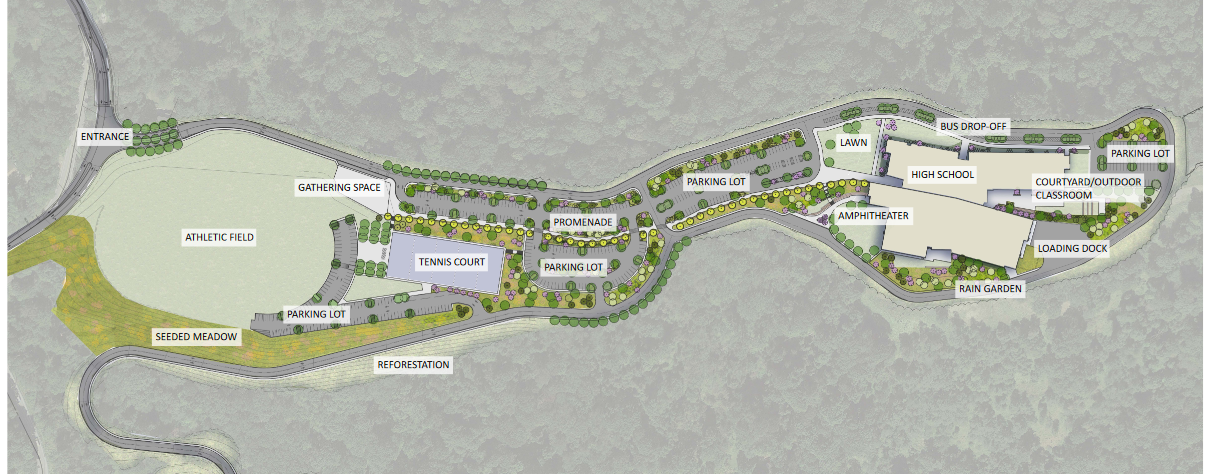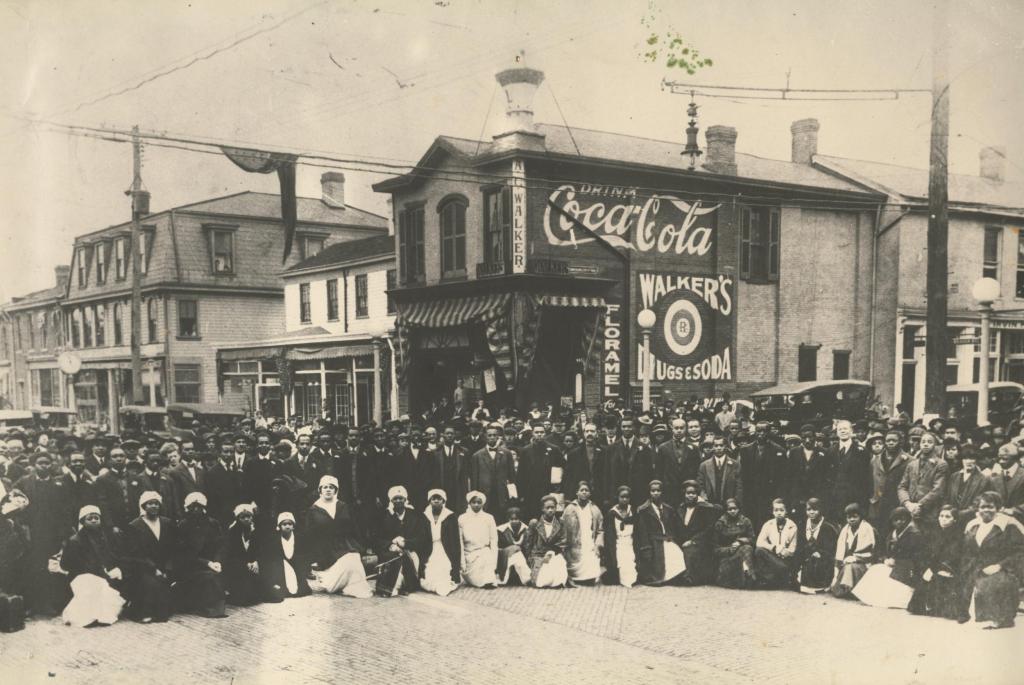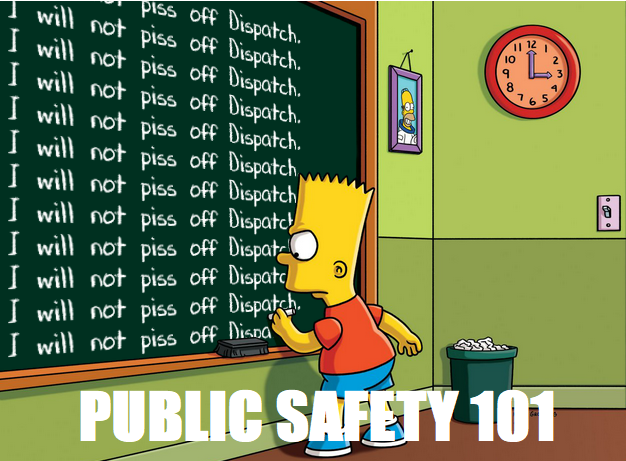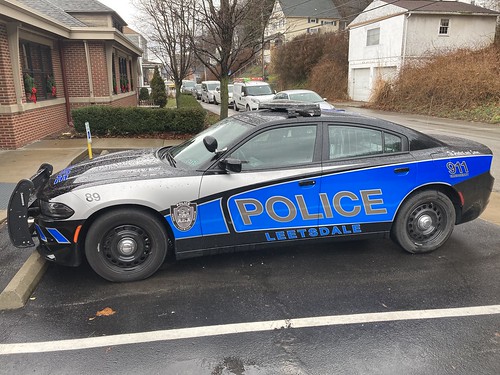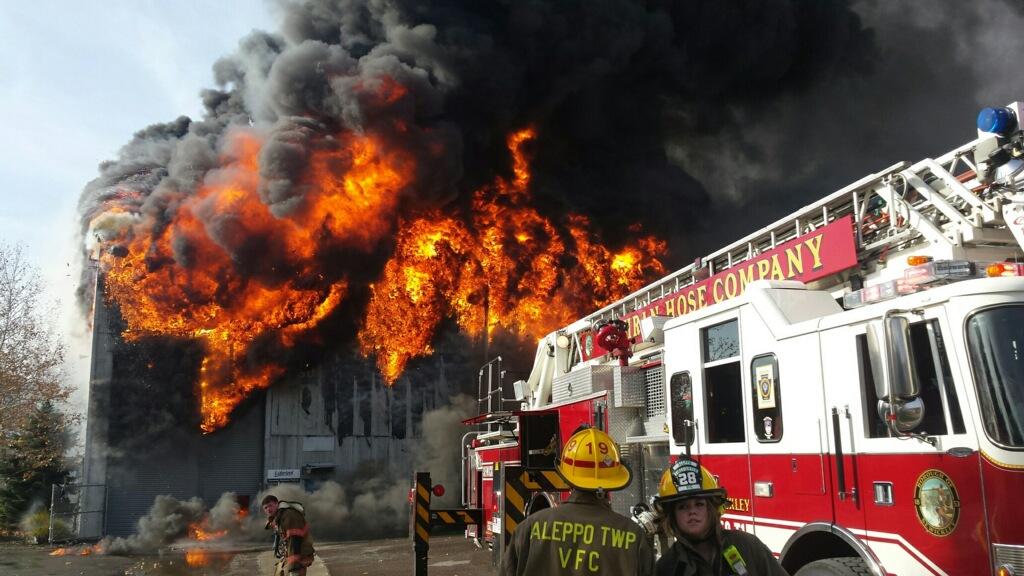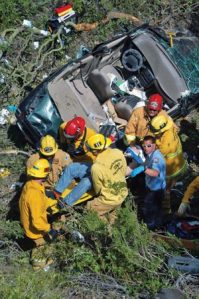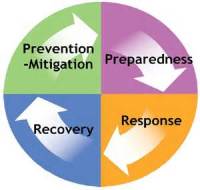We are drowning in information, while starving for wisdom. The world henceforth will be run by synthesizers, people able to put together the right information at the right time, think critically about it, and make important choices wisely.
– E. O. Wilson

Drone view of scene on Riverview Road in Crescent Township, March 12, 2024. The Ohio River and Dashields Dam are visible in the upper left. Click to enlarge – KDKA-TV
It’s been an eventful several weeks for our public safety responders and emergency managers. Events mostly related to weather, including flooding, evacuations, and road closures, involved much of the resource capital of our emergency response community.
This begins with and includes the access points and system coordinators for the bulk of those resources – the public safety telecommunicators who field 9-1-1 calls and dispatch resources to all manner of requests for assistance.
 The second week of April is annually designated to recognize the contributions of this often unseen but critical component of public safety and government. While mostly associated with the 9-1-1 system nationwide, many telecommunicators work in dispatch centers that do not take 9-1-1 calls directly, but have calls routed to them in specialized environments. This can include aviation, maritime, industrial, education, and health care.
The second week of April is annually designated to recognize the contributions of this often unseen but critical component of public safety and government. While mostly associated with the 9-1-1 system nationwide, many telecommunicators work in dispatch centers that do not take 9-1-1 calls directly, but have calls routed to them in specialized environments. This can include aviation, maritime, industrial, education, and health care.
This year included a small cause for celebration, as a bill to change the job classification of 9-1-1 personnel from clerical staff to first responder has just passed the state House by a wide margin, and is headed for consideration by the state Senate.
In Allegheny County, the coordination of first responder resources happens largely under one roof, with notifications to other involved stakeholders being disseminated from the same place, with largely the same information. This is advantageous because the fewer times a message has to be relayed, the more accurate the message is delivered. Think back to if you ever played “Telephone” as a kid.
Significant incidents have touched the local area or presented challenges requiring the adjustment of daily routines and/or heightened situational awareness, similar to events from last year. Below is an exploration of how local and regional governments leverage best practices to keep citizens informed of important issues…or not.
Mine is the last voice that you will ever hear…Don’t be alarmed.
How agencies of government communicate with citizens about occurrences that require their attention is something that has been in a state of flux and redevelopment for at least the last 20 years.
The system that many of us grew up with as the Emergency Alert System (or its predecessor, the Emergency Broadcast System) is now part of the Integrated Public Alert and Warning System, or IPAWS.
This is what I call the “top layer” of notification systems – the one with the capability to reach users across multiple jurisdictions and platforms, including the entire nation if needed. Typical content of these messages include severe weather warnings, AMBER alerts, and disaster and/or evacuation orders, but can also include 9-1-1 system outages. All wireless phones are pre-programmed to “opt-in” to the Wireless Emergency Alerts component of the IPAWS framework. Current IPAWS activity nationwide can be viewed online at the PBS WARN (Warning, Alert and Response Network) website.
Over the last several years, municipal governments in our area and others have contracted with private providers such as OnSolve CodeRed and RAVE Mobile Alert / Smart 911 to alert residents and others who register with the service through the municipality or online. These systems represent a secondary layer of notification specific to the municipality in question – even though many emergencies can (and often do) transcend municipal boundaries.
A review of websites for the 11 Quaker Valley municipalities showed that 6 of them indicate the availability of a community alerting solution. Over the last several weeks I submitted a list of questions to each, requesting information on the nature and operation of their system –
Who is the official with primary responsibility to administer the system for your municipality, such as registration, updates, testing, etc.?
Which municipal officials are authorized to access the system, compose, and send an alert?
Are there written guidelines and/or policies that define the criteria to generate an alert? If so, does this policy address contingencies for sending alerts on a 24/7 basis?
Below is a list of the municipalities so equipped, the system they use, and their responses –
Aleppo Township (CodeRed) – Multiple emails to both the Township Manager and Emergency Management Coordinator (EMC) did not receive a reply.
Bell Acres Borough (Swift911, operated by RAVE) – Borough Manager Lisa Fleming stated –
The alert notification system is administered by the Borough Manager. Currently, the Borough Manager and Borough Secretary may access the system. The Borough does not have written guidelines or policies to define the criteria to generate an alert.
Leet Township (RAVE) – Per Township Manager Betsy Rengers, administrative and access responsibilities are shared by herself, the Police Chief, and the EMC. As far as policy development and 24/7 contingencies, “it is at the discretion of the three people listed as when to send an alert. The Fire Department Chief may be involved, also”.
Leet officials made recent use of the system to warn residents of the Fair Oaks neighborhood of localized flooding from Big Sewickley Creek due to the heavy rainfall during April, and the likelihood of basements taking on water.
Leetsdale Borough (RAVE) – Mayor Sandra Ford stated that she and the Police Chief have access to the system, as well as decision-making authority to compose and send an alert. She also stated that “if we feel another person should be on this we would not hesitate to add an additional administrator”.
Mayor Ford also added that the borough recently upgraded their choice of alerting platform to one that allows them to determine what constitutes an emergency –
Last year, we switched to a new Rave alert system. This would be for an emergency, or any announcement that we want to send out to the residents.(trash pick up, boil water alert, community events etc.)
The old system Rave determined if its an emergency or not. This did not work too well…Leetsdale Council considered the extended plan because last winter we had an ice storm and the residents on Washington Street lost their power. We opened the community room for a warming center and prepared hot food and drink. However, we were unable to notify the residents so we had to go door to door to notify them…The hardest part of this system is getting everyone signed up to receive messages.
Sewickley Borough / Glen Osborne Borough (CodeRed) – Sewickley also provides alerts to Glen Osborne residents with this newly procured system, using a separate group on the same platform. Sewickley Council President Cynthia Mullins stated the following –
The individuals with primary responsibility for administration of the alert system are the police chief and the borough manager. In addition, one staff person and the Emergency Management Coordinator are able to access the system 24/7.
Registration and testing has been a cooperative effort between the EMC and borough staff.
Our experience with this system is in its infancy. As such, we are in the development stage regarding policy. I think the decision makers agree the use of this system is reserved for true emergencies.
Glen Osborne Secretary Diane Vierling and Mayor Barbara Carrier did not respond to emails requesting comment. However, Mayor Carrier did have something to say while wearing her hat as President of the Board of Delegates of the Quaker Valley Council of Governments (QVCOG).
The minutes of the March 20 Delegates meeting contains the following –
President Carrier cited a house explosion that occurred in Crescent Township on March 12th. She noted the explosion could be heard throughout the Sewickley Valley and debris was found as far as the Quaker Village Shopping Center. Citing that Glen Osborne Borough’s Emergency Management Coordinator was out of town, she noted that a regional emergency notification would have been valuable to ease the concerns of local residents.
I was interested in finding out more about what efforts, if any, existed to provide guidance to the numerous independent local governments in our area, over and above the vendors themselves.
QVCOG Executive Director Patrick Conners provided a comprehensive response to my questions on this topic –
Our organization does not procure, manage, or recommend any individual community alerting system(s) for our 15 (fifteen) member communities. The science of emergency management and organizing public notification when incidents arise is a very complex challenge for any municipality. We commend any community, member or not, that seeks to go the extra mile with the integration of an emergency notification system. While the topic of working towards a joint bid or purchase of one emergency notification system has been briefly discussed in the past, due to the complexity of the initial integration for over a dozen communities and the existing product relationships that many communities already have, nothing substantial was achieved on that front. Please keep in mind, each community is unique. Finding a “one size fits all” solution for such a complex issue is a real challenge.
This brings up a good question – while we have the wide-ranging, major incident-oriented capabilities of IPAWS with specific guidance for approval, composition, and authentication, are there any guidelines or templates for assuring that a community’s alert system or best practice can effectively perform its intended function, or interact with other systems when needed?
After Mr. Conners’ response, I started checking with agencies at the county and state level, and cannot locate any readily accessible, government-produced online resource (other than the IPAWS best practices guide referenced above) that offers guidance to municipalities or other organizations that choose to implement an alerting system.
The problem with silos is that they cause people to focus insularly on the specific mission contained within their agency…Government must ensure that the structure and procedures necessary to see the big picture and accomplish the broad goals are in place and enabled.
– Scott D. Pattison
So what we seem to have in place is basically this –
- IPAWS provides a unified framework to push alerts of critical importance over a wide geographic area.
- Since local municipalities appear to largely function as silos with regard to alerting policies (and other things), the frequency, subject matter, and content of locally-originated alerts may vary widely.
- Municipalities and related agencies often rely on social media accounts to make announcements to their communities. Unofficial social media pages are also relied upon by citizens, but there is no guarantee that these sources will relay information that is not misleading or inaccurate.
While searching for more information about alerting systems, a directed ad alerted me of a single solution that facilitates alerting of specific stakeholder groups, public alerts that require pre-registration, and an interface with IPAWS for incidents that require it.
The vendor for this system, CivicPlus, markets it as part of an entire suite of software solutions for local government. This includes the creation of municipal websites – Leetsdale and Sewickley have utilized their services for this.
Amid this cacophony of alerts, we can also add water utilities and schools. Four of the five water authorities (Ambridge, Edgeworth, Sewickley, and West View) that provide and/or distribute water to the 11 Quaker Valley communities also promote an alerting solution on their websites. The Aleppo Township Authority does not.
The Quaker Valley School District also employs the SwiftK12 school alerting solution.
The two words ‘information’ and ‘communication’ are often used interchangeably, but they signify quite different things. Information is giving out; communication is getting through.
– Sydney J. Harris
When I wrote about this general topic last year, it was in response to incidents that illustrated vulnerabilities in our own area and others that could relate to our area. These types of things have continued to occur into this year – the exploding structure in Sewickley Heights, along with the subsequent blast in Crescent, raised concerns in municipalities adjoining the actual location of the incidents.
Multiple failures of both infrastructure and situational awareness, and their impact on alerting citizens, were cited by the Attorney General of Hawaii in response to the first of many reports on the devastating, fatal wildfires that overtook and destroyed much of the town of Lahaina on Maui, resulting in over 100 deaths. This has also been a significant challenge for Hawaii’s Governor, Josh Green, who along with being an emergency physician is a Sewickley-area native and QV alumnus.

Barges collect against the Emsworth Lock and Dam after breaking loose from their moorings in Pittsburgh in the early hours of Saturday, April 14. Click to enlarge – Northside Action News / NAN Media
Issues with alerting and notification aren’t just limited to government agencies or social media influencers. Local news media has a responsibility to facilitate community readiness by the timely relay of important news and information – hence the reason for all those (at times annoying) weekly and monthly tests of the Emergency Alert System.
As someone who oversaw a 9-1-1 center’s interface with EAS, I learned one of the most important lessons related to these periodic tests – never send one during the last 10 minutes of Law and Order.
The broadcast media places great emphasis on news gathering and dissemination as part of their required commitment to public service. So when they are conspicuously absent from the initial coverage of a significant occurrence, it tends to stick out.
Such was the case late in the evening of April 13, when 26 barges tore loose from their moorings and floated freely down the flood-swollen Ohio River, requiring bridges be closed until the barges floated clear of their supports. The following afternoon one barge did strike a pier of the Sewickley Bridge, necessitating its closure until an inspection could be completed. This generated interest among many, some of whom had the catastrophic March 26 collapse of the Francis Scott Key Bridge in Baltimore fresh in their minds.
The barge incident occurred at about 11:25 PM on a Friday. When I awoke for work at 4:30 the following morning, CNN and the New York Times both had stories posted. However, no major Pittsburgh media outlet had anything about it at all. The only local media with anything online was Northside Action News (NAN Media), along with the popular Pittsburgh Scanner page on X (Twitter), which had tweeted information out in real time.

Charlie Bragale works the assignment desk at WRC Channel 4 in Washington, DC. – WRC-TV
The first “establishment” Pittsburgh media with any reporting online was WTAE, which posted it at 5:44 AM – over 6 hours after the barges broke loose.
There is definite potential in our region for entrepreneurial online media to leverage the mobility and flexibility that its format provides, especially with breaking news, and even more especially after hours.
Perhaps the era of the Assignment Editor is past its prime in the Pittsburgh media landscape, but as society continues to re-acclimate into one that works and plays on a 24/7 basis, and craves information that may affect them, a responsive news media needs to adapt as well.
An example of such an effort was brought forth last week. When heavy rains and flooding impacted Santa Cruz County, California in early 2023, a small online news site that covers the county put its staff on 12 hour shifts and fanned them out across the area to document and report on the damage and human impact. For their efforts they received the 2024 Pulitzer Prize for Breaking News Reporting.
Alerting technology is something that will not be effective without development of a best practice for its operation – one that addresses the technology itself, the processes that govern activation, and properly orienting / training people about both. Procedures about who can activate, for what, and the content of any alert message need to be in place before the app goes live, and should be tested periodically to assure its continued effectiveness.
I wrote the (very long) sentence above. It was part of last year’s post about the same general topic. The concepts surrounding a best practice, and how to achieve it, have been a benchmark of how I have approached things over the last 30 years or so.
I remain resolved in my belief that government at all levels, as well as private concerns and mass media, can do better in the area of keeping people informed about situations and conditions that may affect them.
This isn’t to say that there aren’t many fine examples of this in action. The wide-area alerting systems that make up IPAWS are frequently tested and competently administered, with problems identified and addressed on a regular basis.
PennDOT District 11 makes a solid, conscientious effort to assure that road closure and construction information, both routine and unplanned, is communicated to stakeholders and the public through tools such as their website, email distribution lists, and social media pages.
Unfortunately, it appears as if the the next tier of alerting is driven by opinions and approaches that are as varied as there are little local governments dotting the landscape of our commonwealth – each seemingly with its own agenda, at times resistant to cooperation with others, with some clearly in denial as to the anachronistic nature of their existence.
A report in the Tribune-Review this past Friday highlighted the inherent difficulties of merging municipalities in Pennsylvania, but also profiled a recent merger in Mercer County and gave the impression that more and more municipalities may be forced to consider these steps in the interest of safety, efficiency, and fiscal responsibility.
Have a good spring into Summer.







